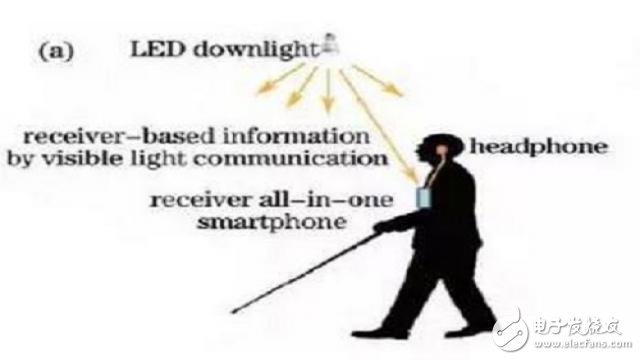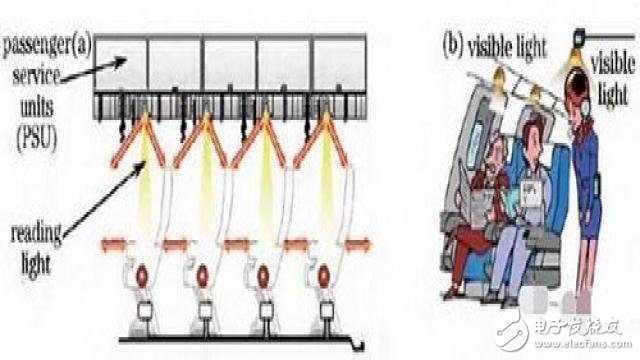In addition to lighting advantages, LEDs also feature short response times and high-speed modulation. The light flicker caused by the high-speed modulation of the white LED is not easily perceived by the human eye, and can provide the function of data communication while lighting. The technology for data communication in the visible spectrum of 380-780 nm is referred to as visible light communication (VLC) technology. VLC has great potential in medium and short distance secure communication, high precision and accurate positioning, transportation communication and indoor navigation, especially in place of radio frequency (RF) to solve the "last 1m" problem. Compared with radio waves, visible light communication has many advantages: 1) the amount of information is developed by Moore's Law, many frequency bands of the radio spectrum are occupied, and VLC uses the visible light spectrum higher than 3THz and still belongs to the white space spectrum, and is not subject to the license. 2) visible light can not penetrate the building wall, the VLC signals in the adjacent closed unit do not interfere with each other, high security, good confidentiality; 3) visible light transceiver device is simple and inexpensive; 4) visible light wavelength belongs to submicron Level, has obvious advantages in accurate direction positioning; 5) VLC can replace the application of radio in certain electromagnetic interference sensitive specific occasions (such as aircraft, hospitals, nuclear power plants or oil drilling). 1, indoor positioning The RF, Bluetooth, and ultrasound methods used in the indoor positioning system have problems such as low system stability, long response time, large electromagnetic interference, and low accuracy and accuracy. The VLC is immune to electromagnetic interference and enables fast and accurate positioning and navigation through a fixed indoor light source. In the future, large shopping malls, underground shopping malls and other places can be targeted and guided by the VLC-based intelligent pedestrian automatic support system to reduce the losses caused by customers not finding the specific location of the goods. Similar applications can be extended to airports, museums, and other digital positioning broadcasts. The VLC indoor positioning system has different positioning accuracy depending on the requirements. For the positioning of indoor pedestrians or mentally retarded navigation, medium accuracy can be used. However, the positioning accuracy requirements for robots and the like will be higher. (1) Indoor pedestrian navigation The indoor navigation system that helps the visually impaired person recognize the position, as shown in the following figure, the LED is mounted on the ceiling, the smart phone with the geomagnetic sensor is hung on the user's neck, and the smart phone is connected with the earphone. The mobile phone receives the ID information transmitted by the LED through visible light communication, obtains the direction of the light source and the positioning information; the path is optimized and the result is transmitted to the earphone to guide the pedestrian. The test results show that the tester can accurately locate and navigate within the range of 1~2m, and can achieve direction correction within the range of -59°~66°. VLC positioning navigation system developed in combination with wall signage panel LED light source: The system is designed with filters to reduce background light interference. Through VLC, the user's mobile phone receives navigation information from the signage panel LED. The navigation information includes the location information of the signage panel and the optimal intensity point at which the visually impaired person reaches the downloadable data information. In this system, the data transmission rate of the navigation signal is 62.5 kb/s, and the data information transmission rate is 1 Mb/s. In the test, the visually impaired person can receive the navigation signal transmitted by the LED light on the sign panel about 5m away through the earphone. When walking to the signage panel about 1m away, the visually impaired receiver can automatically perform when the light intensity is sufficient. Text information download and storage. (2) accurate indoor positioning Precise positioning is required in many applications such as robotics and drone (UVA) control systems. How to obtain high positioning accuracy under the premise of ensuring that the system complexity is not high is a hot research topic. There are many ways to get the target position, such as measurement signal arrival angle (AOA), time of arrival (TOA), time difference of arrival (TDoA), and received signal strength (RSS). There is an RRS-based indoor positioning system that does not require synchronization. The test results show that accurate positioning is achieved with a 95% accuracy rate within 5.9 cm. There is also an indoor positioning system based on a bit filling method that receives a signal strength/time division multiplexing mode (RSS/TDM). The bit stuffing method enables measurement of instantaneous signal strength without interference from various optical signals. In this system, 16 LED lights with a 40 cm spacing between each other form a square array fixed to the ceiling, and the VLC receiver is mounted on a robot 170 cm from the ceiling. The test results show that the robot successfully achieves autonomous navigation of five target point planning paths within the error of less than 3cm. In addition to image capture and data reception, the image sensor has better anti-interference ability than the photodiode as a receiver due to the difference between the externally disturbed light source focusing pixel and the VLC ideal signal focusing pixel. The application of image sensors for accurate positioning in VLC has received more and more attention. The Wireless Standards Area Network (WPAN) IEEE Standards Organization P802.15 working group is already considering how to incorporate positioning into camera communication standards. Several application studies on image sensors. The following figure (a) shows the simultaneous acquisition of image and position information at the receiving end. (b) is the application of the image sensor on the robot. Two image sensors fixed on the robot detect the position of the robot by the information sent by the LEDs. One of the image sensors captures the direction of the incident light, and the other image sensor continuously captures the high-speed frame image and parses the data from the visible light. Test results show that the robot can achieve precise positioning within a centimeter range. (c) Using image capture and visible light communication to achieve accurate positioning of the water tank 50m away, the positioning accuracy reaches millimeter level. 2. Intelligent Transportation System (ITS) information transmission Intelligent Transportation Systems (ITS) reduce traffic accidents, traffic congestion, and fuel consumption by timely acquiring and transmitting information about traffic conditions. Image processing can be used to help drivers identify traffic lights, obstacle detection, vehicle and vehicle, and information capture between vehicles and road facilities. It is a key technology for ITS. High-speed data image sensors combined with VLC have broad application prospects on ITS. The document records the communication between the roadside device and the vehicle using LED light and a camera with a frame rate of 1000 frames/s and a resolution of 1024 pixels & TImes; 1024 pixels installed in the car. The real vehicle test verified that the system can accurately receive data transmitted from 256 LEDs arrays in a 35m range at a speed of 30km/h. At present, there are some technical problems to be solved in the application of high-speed image sensors in VLC: if the installation facilities are expensive, complex real-time image processing technology is required, and the camera frame rate is lower than the reaction speed of the LEDs, thereby limiting the communication speed. The literature reports on the application of the newly developed Optical Communication Image Sensor (OCI) in Wireless Optical Communication (OWC) systems. The newly developed OCI with complementary metal oxide semiconductor (CMOS) image sensing technology has two features: communication pixels for high-speed signal reception (CPx) and 1-bit flag image output for fast and accurate LED detection. The OWC system is known as the world's first pixel transmission communication system with a 16.6ms delay and 20Mb/s transmission rate. 3, VLC high speed data transmission Access to information such as high-definition (HD) video streaming, high-speed streaming, and high-speed data backup has become an integral part of contemporary life. Visible light can be transmitted by using a light column with a small divergence angle, and the low transmission loss of the path enables high-speed bandwidth. Secure data stream download and transfer is possible. As shown in the figure below, the European OMEGA project developed a VLC data transmission with 4 HD data streams of 100 Mb/s. Data transmission is performed on a photodiode detector in a range of 10 m2 by 16 LED light sources using orthogonal frequency division multiplexing (OFDM) technology. A demonstration system for 5m & TImes; 5m & TImes; 3m indoor video and audio high quality broadcast transmission by adding a focus lens between the VLC receiver and the transmitter: the Nd-LOS link has a network compared to the line of sight (LOS) link The node has good mobility and strong tracking, but its link loss leads to low transmission rate. In order to carry out research on this problem, a typical indoor two-way optical wireless communication system with a transmission rate of 2M, 400 Mb/s and a bit error rate RBE "10-8" (visible LED as a downlink transmission source, IR is an uplink) Data transmission source). RGBLEDs use wavelength division multiplexing (WDM) to achieve higher data transfer rates. The document records the first VLC system based on wavelength division multiplexing/discrete multitone (WDM/DMT) modulation technology, which modulates a single white RGB-LED and achieves 803 Mb/s data communication. 4. VLC is applied in aviation VLC has an obvious advantage in aviation. Visible light LEDs have been promoted and applied in a new generation of commercial aircraft. Communication through visible light instead of optical cables or cables can reduce volume and weight, reduce electromagnetic interference (EMI) and reduce costs. Boeing commercial aircraft platforms are also developing future wireless optical network solutions. the study. Application of passenger reading light service units (PSUs) based on VLC communication, entertainment system and cabin intercom: The reading light in the following figure (a) illuminates the passenger seating area, while the reading light is received as an optical communication source to the passenger laptop or other terminal The machine transmits data. The passenger entertainment system forms a high-speed mesh network through the visible light communication between the entire array of seats, and realizes the transmission of in-flight entertainment (iFE) information. Optical signals from LED lights can also be used as low-bandwidth voice communications for inter-machine intercom, as shown in (b). 5, underwater VLC Underwater communication plays an important role in military, industrial and scientific fields. Underwater communication rate requirements range from a few megabits to tens of megabits or even higher. Seawater in radio waves is highly attenuated. Sound waves transmit at a speed of 1500 m/s in the ocean, with long delay times, limited bandwidth, and high bit error rates. Sound waves can also interfere with marine animals such as dolphins and whales. VLC can overcome the problems of attenuation and electromagnetic interference under water. About VLC communication system development between the controller and the underwater remote transport vehicle: The transmitter in this system consists of 70 LED light sources, supporting data transmission in the 120° viewing angle range, and the transmission rate is up to 20Mb/s. The literature records the specific application of underwater visible light communication systems in nuclear power plant machine testing. The underwater remote transport vehicle is equipped with a video and control signal transmission between the camera and a 20m remote station. At present, the main challenge of underwater optical wireless communication systems is that it is difficult to achieve long-distance communication due to underwater nature, especially turbidity. In response to this problem, the National University of Singapore and the Massachusetts Institute of Technology carried out research and demonstration of a 1.2 Mb/s underwater optical communication system within a distance of 30 m. Iron Chandelier,Mid Century Chandelier,Hanging Chandelier,Modern Chandelier Lights GUANGDONG LAVIUS LIGHTING CO., LTD. , https://www.laviuslighting.com



